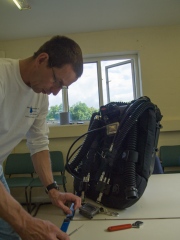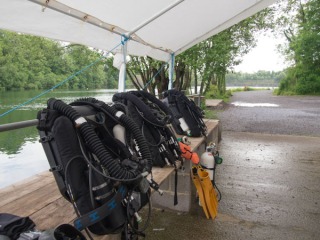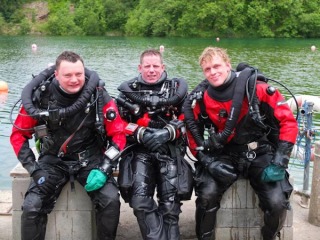The scholarship really opens a lot of doors, and I have the pleasure of walking through them.
I have relocated to England where I have spent the last week learning how to dive with a Closed Circuit Rebreather (CCR) under the guidance of Phil Short. I arrived at the B&B the evening before the course started and soon realized that the lady who runs it was a very special woman but who made every effort to make the guests feel at home. Before I knew it I was seated on the sofa and served more food than one person can possibly handle. Later in the week I understood that this was not even considered a meal but simply nibbles to go with the The.
First day of the course Phil came and picked me up and we headed over to the dive site at Vobster Quay, a quarry not far off and an excellent place for courses with easy access to the water and friendly staff. There we met up with the only other student Maciej, a course director from Poland and with the CCR instructor candidate John who would assist in the training. The rebreather we were about to learn how to handle was the Sentinel from VR technology and the entire first day we spent looking at how it works. Phil took his entire machine apart and showed us what all the little parts were and how we as users could maintain them in good condition. Since the rebreather is there to maintain life support in a hostile environment, namely underwater, it is essential that you as a user know how to take care of it. When we had watched Phil assemble his unit it was our turn to give it a try. You hear a lot about how the preparations for CCR diving take all the time in the world but after this week I would like to say that it just isn’t true. Even Maciej and I who were completely new to the machine could handle the basic pre assembly of the machine without too much stress and by the end of the week, without assistance. So when the units were ready to dive we put them aside, called it a day and went back to the B&B for nibbles and some more theory.
Next day we geared up and went through the predive checks and entered the water. We didn’t exit the water until 108 minutes later… Now that is a long time to sit and do exercises on a platform. I would recommend anyone that wants to relive their first moment as divers again to try a rebreather. The things you take for granted like buoyancy or breathing patterns are completely changed. Basically you take a few steps back in your diving and that can be a tough experience, but I think it was also an eye opener. If you can cope with the feeling that you have to start over there are a lot of benefits to be had. For me as an instructor it was a humbling experience to feel like a total newbie again.
Next dive we pulled another 108 minutes making our first day’s diving more than three and a half hours in the water. The first day’s exercises were a lot about handling bailing out to your backup gas which makes sense since you first of all want to be able to handle something going wrong before anything else. We topped off the day with an English dinner served at the B&B which consisted of three courses and showed that the English kitchen has an undeserved bad reputation. Next day we worked on how to manually control the rebreather in the event of a failure. It wasn’t that hard but sure a little nervy when Phil helped us to turn the rebreather off underwater. I have never been so focused on a set of numbers as when I swam around staring at my backup display, maintaining a breathable mix in the loop. This third day in the water was when we started to feel a little more relaxed and could enjoy it more. Maciej summed it up pretty well when he said that this was he first time he felt like he was diving with the machine and not the other way around.
The next day England gave us some of its famous fog which after a while shifted to rain. Luckily the dive centre was well prepared and had plenty of areas where we could gear up under a protective roof. Diving-wise we practiced how to use offboard gas and handling decompression. It was really neat how the heads up display shows your deco information as well as most of the other information you need making it possible to actually look around a bit and not only stare at your displays all the time. After a hard day of diving and being rained at, another three course dinner waited for us and it resulted in a food induced coma for me. It can’t be healthy to eat that much, but it sure was good! Last day we had already completed all exercises and were more or less ready but did a dive where we could spend more time just swimming around, looking and getting the feel of the machine. We also repeated some exercises that we felt we wanted to have another go at. When we got out of the water we disassembled the machines and disinfected the breathing loop. Since the breathing loop is essentially a continuation of your own airways any germs that grow there can easily be transferred to you if you don’t rinse it carefully. I disassembled the machine thinking that I had only just begun to learn how to use it. I will definitely try to spend more time on CCR in the future, how near that future is we will see.
This concluded five very intense days of training and I would like to thank Phil for great instruction, if you want to do technical CCR diving there are few people out here as competent. I´d also like to thank John for assisting Phil and Maciej for being a very calm and competent dive buddy throughout the week. Right after the course I also had the opportunity to ride shotgun as Maciej tested Phil’s statement that the fastest car is a rental. Where we drove I will tell you in my next post!












